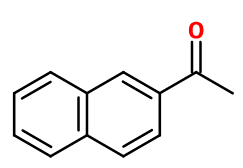
Photo credits: ScenTree SAS
Oranger Crystals®
Methyl Naphtyl Ketone ; 1-naphthalen-2-ylethanone ; Beta-acetonaphthalene ; 2-acetonaphthanone ; 2-acetylnaphthalene ; Cetone D ; 1-(2-naphthalenyl)-ethanone ; Methyl 2-naphthyl ketone ; MNK ; 1-naphthalen-2-yl-ethanone ; 2-naphthyl methyl ketone

Photo credits: ScenTree SAS
| Company | Ingredient Name | ID | Comments | Naturality | Certifications | Purity | Latin name | Treated part | Geographical origin | MOQ |
|---|---|---|---|---|---|---|---|---|---|---|
|
|
Oranger Crystals - 30 Gr | - |
Visit website
|
- | - | - | - | - | - |
General Presentation
-
CAS N° : 93-08-3
-
EINECS number : 202-216-2
-
FEMA number : 2723
-
FLAVIS number : 07.013
-
JECFA number : 811
-
Appearance : White solid
-
Density : <1,5
-
Volatility : Base
-
Price Range : €€
Physico-chemical properties
-
Molecular formula : C12H10O
-
Molecular Weight : 170,21 g/mol
-
Log P : 2,9
-
Fusion Point : 54°C
-
Boiling Point : 301°C
-
Detection Threshold : Donnée indisponible.
-
Optical rotation : Donnée indisponible
-
Vapor pressure : Donnée indisponible
-
Refractive Index @20°C : Donnée indisponible
-
Acid Value : Donnée indisponible.
-
Flash Point : 154°C
Uses
Uses in perfumery :
Oranger Crystals® is used in orange and white flowers notes for a warmth supply. Used in soaps and detergents for its stability. Tends to flatten formulas if overdosed.
Year of discovery :
1892
Natural availability :
Oranger Crystals® is not available in its natural state.
Isomerism :
alpha-Methyl Naphthyl Ketone, also known as Oranger Liquid®, is a liquid that also has a smell similar to orange blossom. This compound is nevertheless dissociated from Oranger Crystals® in perfumery. Diphenyl Oxide is an isomer of Oranger Crystals®, but it has a very different smell as it is rosy and fruity.
Synthesis precursor :
Oranger Crystals® is not a precursor to the synthesis of another compound of olfactory interest.
Synthesis route :
Oranger Crystals® is synthesized from naphthalene by a Friedel-Craft acetylation, and by reacting it with chloroacetic acid for example, in the presence of aluminum chloride. The more polar the solvent used in the synthesis, the larger the quantity of beta isomer in Orange Crystals®. The alpha product is not desired.
Regulations & IFRA
Allergens :
This ingredient does not contain any allergen.
IFRA 51th :
This ingredient is restricted by the 51th amendment
- Quantitative limit on the use :
-
Cat.1 Cat.2 Cat.3 Cat.4 Cat.5A B C DCat.6 0,2 % 0,2 % 0,2 % 0,2 % 0,2 % 0,2 % 0,2 % 0,2 %0,2 % Cat.5A B C DCat.6 0,2 % 0,2 % 0,2 % 0,2 %0,2 % Cat.7A BCat.8 Cat.9 Cat.10A BCat.11A BCat.12 No Restriction 0,2 %0,2 % No Restriction No Restriction 0,2 %No Restriction 0,2 %No Restriction Cat.10A BCat.11A BCat.12 No Restriction 0,2 %No Restriction 0,2 %No Restriction
-
Restricted ingredients due to phototoxicity considerations: notes
This Standard is set due to the phototoxic effects of Methyl β-naphthyl ketone. For more detailed information on the application of this Standard, please refer to the note on phototoxic ingredients in chapter 1 of the Guidance for the use of IFRA Standards.



